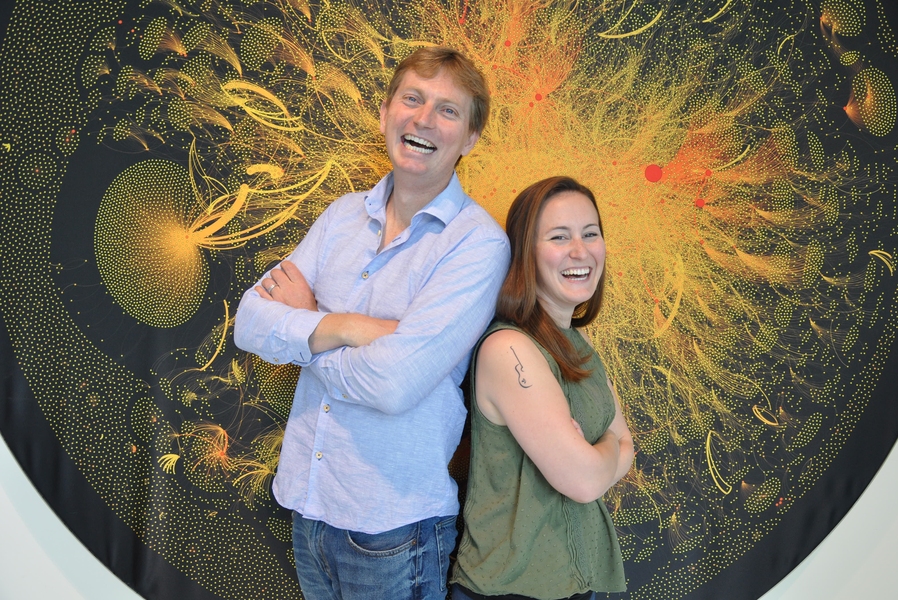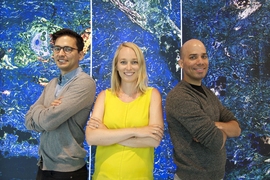MIT’s Department of Biology is welcoming two new assistant professors, Joey Davis and Rebecca Lamason, this September. The duo will augment the department’s efforts in basic research, probing fundamental facets of cellular processes like molecular degradation and bacterial infection.
“I am thrilled that Becky and Joey have joined our department,” says Alan Grossman, department head. “They bring new research areas and approaches that fit well with our overarching goals to help solve fundamental biological problems. I anticipate that their expertise and interests will enable collaborations within MIT and beyond.”
The arrival of Davis and Lamason brings the number of recent biology faculty additions to five since January.
Joey Davis
Joey Davis investigates how cells maintain a delicate internal balance of assembling and dismantling their own machinery, particularly macromolecules. A cell’s ability to keep the precarious balance of this process in check often diminishes with age, and when it goes awry, disease can ensue.
Born in Durango, Colorado, but raised in Long Beach, California, Davis became interested in how things were built by emulating his construction worker father. Assembling bicycles and other objects spurred Davis’ curiosity about the nuts and bolts of the natural world and he soon realized that, unlike bikes, biological systems were not so easily parsed.
Davis went on to earn dual bachelor’s degrees in biological engineering and computer science from the University of California at Berkeley. He arrived at MIT as a graduate student shortly thereafter, jointly advised by professors Robert Sauer and Tania Baker, both of whom are based in Building 68, where Davis will now run his own lab. He also served as a teaching assistant for 7.51 (Principles of Biochemical Analysis), and as an advisor to MIT’s team for the International Genetically Engineered Machines (iGEM) competition.
Davis became enthralled by molecular disassembly, particularly in bacteria. After a brief foray into the biotechnology sector, he returned to his California roots to pursue his postdoctoral training at the Scripps Research Institute in La Jolla. He brought with him his MIT-inspired fervor for large cellular machinery, and in doing so encountered his macromolecule of choice: the ribosome. Sometimes referred to by researchers as the “construction workers” of cells, ribosomes play a key role in building molecules from genetic blueprints. After three years, he was awarded a K99/R00 Pathway to Independence Award from the National Institute of Aging, which included an affiliation at the Sanford Burnham Prebys Medical Discovery Institute. The award will also help fund his first several years of research at MIT.
In his own lab, Davis seeks to determine how cells assemble and destroy ribosomes and other macromolecules, as well as how they remove harmful protein aggregates and dysfunctional organelles. These functions are often compromised due to age, genetic mutations, and environmental stresses, leading to diseases like cancer, diabetes, and neurodegenerative disorders. Davis says he is excited to further examine these processes at MIT.
“The questions I’m asking about how the degradation system is constructed and how it targets substrates are similar to those I pursued in graduate school — but the answers will likely be completely different,” Davis says. “The members of the MIT research community truly want to know how the natural world works, and that mindset draws me in today as much as it did 13 years ago.”
Davis has been hard at work developing a series of new research techniques, some involving cryo-electron microscopy, a method to image large macromolecules at high resolution. His discoveries could ultimately assist pharmaceutical development — improving antibiotics and anti-cancer therapeutics — and perhaps enabling scientists to one day engineer their own bigger and better molecules.
Rebecca Lamason
Rebecca Lamason investigates what happens when cellular functions are hijacked by unwanted interlopers — namely, the bacteria that cause diseases such as spotted fever and meningitis. Her interdisciplinary work spans multiple fields, including immunology, genetics, biochemistry, cell biology, and microbiology.
Growing up in a family that was interdisciplinary in its own right, composed of both artists and mechanics, Lamason has always sought to examine fundamental questions from multiple perspectives.
After earning a bachelor’s degree in molecular biology from Millersville University in Pennsylvania, she went on to graduate school at the Johns Hopkins University School of Medicine, where she immersed herself in the field of immunology. There she demonstrated how a molecule called CARD11 regulates immune cell activation, a discovery with potential applications for cancer therapeutics. She also served as a teaching assistant for the school's graduate immunology course and co-founded the Immunology Student Journal Club.
It wasn’t until her postdoctoral training at the University of California at Berkeley, however, that Lamason found her model systems: two species of bacteria called Rickettsia parkeri and Listeria monocytogenes.
The two pathogens lay siege to cells in much the same way, entering and leveraging preexisting internal structures to build tails for rapid migration to neighboring cells. Lamason hypothesized that to do so, the intruders must also take over the complex communication systems between cells. Common scientific consensus held for years that Rickettsia, Listeria, and several other species of bacteria spread in a similar manner — using their tails to propel themselves and ram into the host’s cell wall to gain access to neighboring cells. Lamason, however, demonstrated this isn’t always the case and that Rickettsia tend to lose their tails and must then rely on the host cell’s internal machinery instead to invade neighboring cells.
Lamason was drawn to MIT by the diverse array of research efforts that are unified by a collaborative desire to explore the mechanistic details of cellular systems. Like Davis, she received a K99/R00 Pathway to Independence Award in 2015 — in her case from the National Institute of General Medical Sciences. Her lab will continue to investigate the interplay between invasive bacteria and their hosts, aiming to clarify how cell-to-cell spread varies between species. She plans to leverage advanced imaging platforms with tools from cell biology, microbiology, genetics, and biophysics to gain a deeper understanding of how these pathogens manipulate their hosts.
“My goal is to understand this virulence mechanism in order to prevent disease, and to use pathogens as tools to better understand host cell biology,” Lamason says. “This type of study lends itself naturally to interdisciplinary work. I love the challenge of learning new things and using multiple approaches to clarify important biological questions.”








